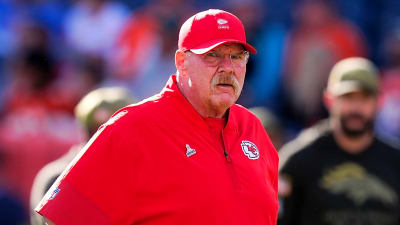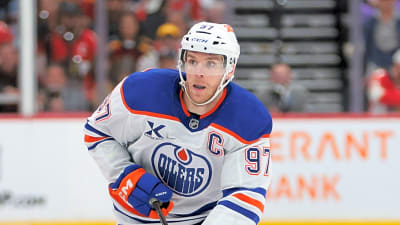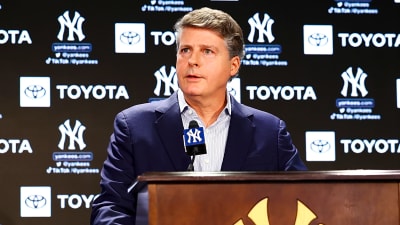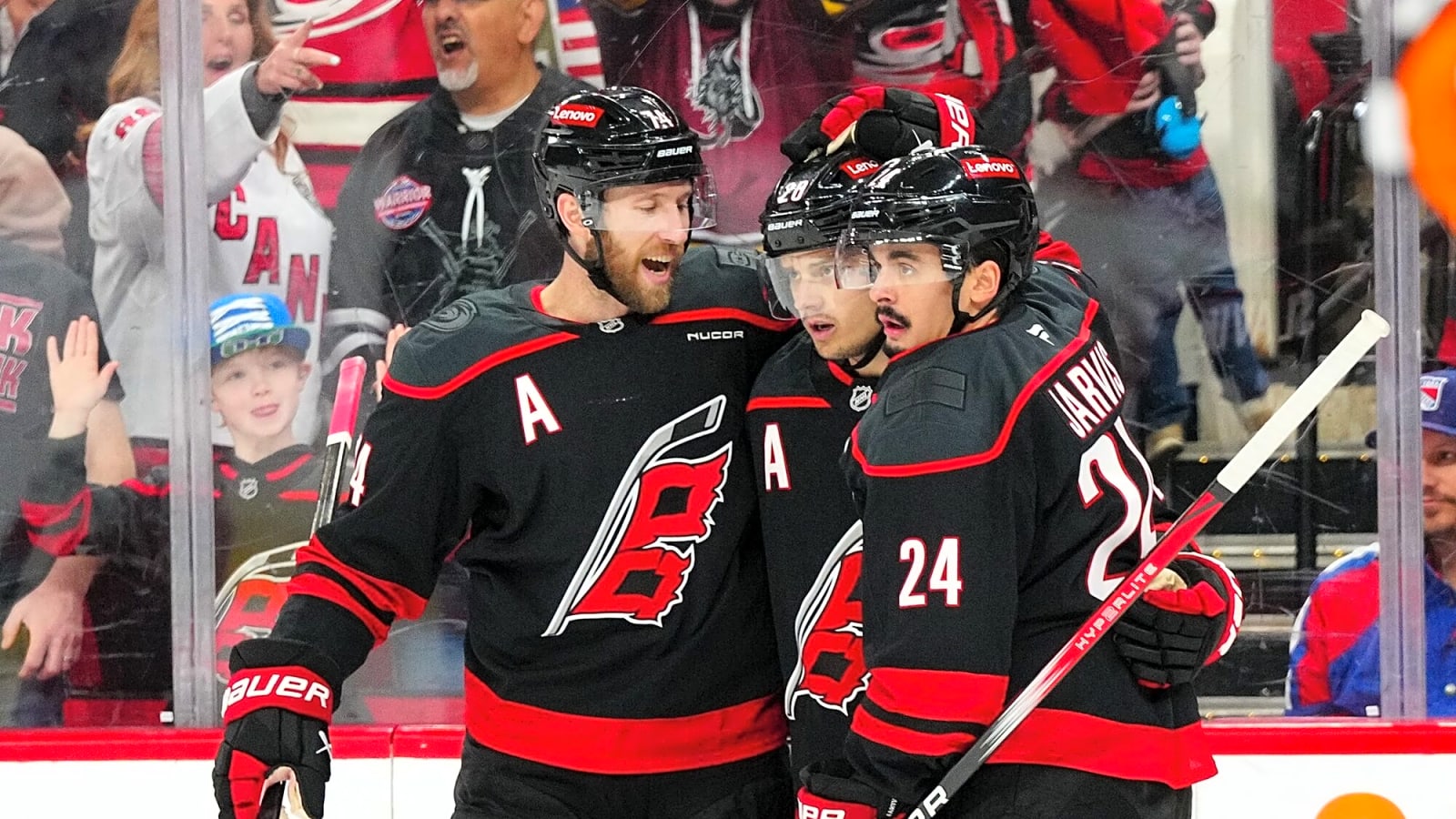
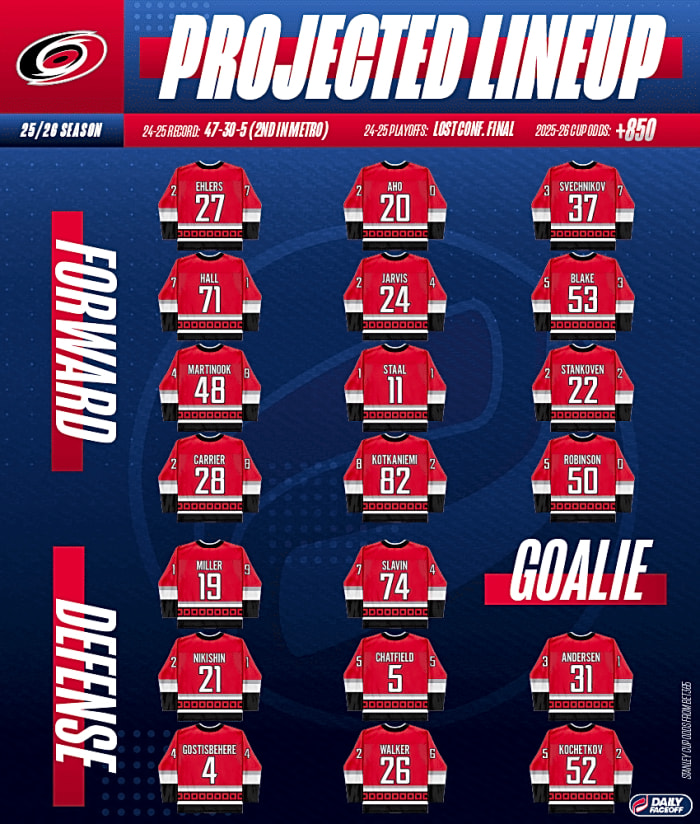
LAST SEASON
It’s low-key astounding that the Hurricanes’ end result in 2024-25 was so familiar given how dramatic and unusual their regular season was.
By winter, the Canes were checking their typical boxes: hovering at or near the top of the Metropolitan Division, playing their usual dominant 5-on-5 hockey under coach Rod Brind’Amour’s aggressive forechecking system, generating the most and allowing the fewest scoring chances in the league. But after their big Trade Deadline acquisition from the season prior, Jake Guentzel, had left in free agency, the Canes knew they were short a marquee forward.
Despite all their success in the Brind’Amour era, they had yet to reach a Stanley Cup Final in six tries, so GM Eric Tulsky made a bold splash. In one of the century’s most shocking in-season blockbusters, the Canes landed superstar right winger Mikko Rantanen from the Colorado Avalanche and left winger Taylor Hall from the Chicago Blackhawks in a three-team deal that required Carolina to sacrifice leading scorer Martin Necas and bottom-six center Jack Drury, plus a second- and a fourth-round pick, to Colorado and a third-round pick to Chicago to retain half Rantanen’s salary. The trade was supposed to signify the Canes hooking that missing piece in Rantanen, a Stanley Cup winner and a dominant playoff scorer.
But Rantanen simply never fit. By Trade Deadline day, he’d sputtered to two goals and six points in 13 games, and Carolina wasn’t confident he’d re-sign as a UFA. Rather than lose a player for whom Raleigh “never felt like home” for nothing, they dealt him to the Dallas Stars for a package including promising young center Logan Stankoven and multiple first-round picks. The return was strong for Rantanen, who immediately signed a lucrative eight-year extension in Dallas, but the Canes somehow ended up without Necas or Rantanen and headed into the playoffs having taken a short-term step backward to go forward in the long term. They made short work of the New Jersey Devils and Washington Capitals in 10 total games in Round 1 and 2 but got steamrolled by the Florida Panthers in the Eastern Conference Final. The Canes had lost 15 consecutive final-four games before squeaking out a single win in that series. Once again, their stingy defensive game wasn’t enough to overcome their lack of true star power.
This offseason, Tulsky remained aggressive, securing a big-time forward for his top six by signing Nikolaj Ehlers and acquiring two-way blueliner K’Andre Miller from the New York Rangers. With several prospects breaking through last season and so much of the team’s core locked up long term, Carolina is positioned to take many more swings at a four-round playoff run. Does that finally happen in 2025-26?
KEY ADDITIONS & DEPARTURES
Additions
Nikolaj Ehlers, LW
K’Andre Miller, D
Mike Reilly, D
Cayden Primeau, G
Departures
Dmitry Orlov, D (SJ)
Brent Burns, D (Col)
Jack Roslovic, RW (UFA)
Scott Morrow, D (NYR)
Riley Stillman, D (Edm)
Spencer Martin, G (KHL)
Jesper Fast, RW (retired)
Dustin Tokarski, G (UFA)
OFFENSE
The Canes’ brand under Brind’Amour is all about overwhelming opponents by peppering them with pucks. They led the NHL in shot attempts, scoring chances and high-danger chances at 5-on-5 last season. That they finished ninth in goals despite tilting the ice like no other team highlights the problem they had converting their looks into goals. They had the 19th-best shooting percentage at 5-on-5 – and, again, that’s despite leading the league in high-danger chances. Their power play ranked a woeful 25th at 18.7 percent. This team consistently struggles to finish. The Canes haven’t even had a 40-goal scorer since Eric Staal in 2008-09, and their last player to finish top-10 in points was Eric Staal in 2012-13.
That said, there’s reason to expect offensive improvement this time around. First off, there’s the Ehlers addition. While his career averages of 27 goals and 63 points per 82 games denote a good, not great, top-six forward, the speedy 2014 first-round pick averages just 16:26 of ice time per game across his 10 NHL campaigns, including south of 16 minutes each of the past three seasons. During that same span, Ehlers sits in the 97th percentile among all forwards in points and shots per 60. What, then, could he accomplish if the Canes are willing to entrust him with even a modest increase to 18 minutes a game? That’s likely to happen given the they committed six years and $51 million to him this summer.
On top of Ehlers’ contributions, we can expect Carolina’s forward group to improve from within. Seth Jarvis, 23, quietly produced better than a point per game over his final 45 games last season. Jackson Blake was a rookie revelation late in the season, scoring six times in his final nine games and earning work on the top power play unit. Those two could stay on the first line between No. 1 center Sebastian Aho – or Brind’Amour could put Ehlers with Aho and move Jarvis back to center, creating a strong second line alongside Blake. Hall and Andrei Svechnikov round out a solidly above-average top six. Then you have Stankoven, just 22, who scored at better than a 20-goal pace between the regular season and playoffs after coming over from Dallas. He can drive the third line alongside Jordan Staal.
Shayne Gostisbehere, new addition Miller and rookie Alexander Nikishin make Carolina’s D-corps a mobile group to boot. Really, everyone can skate on this D-corps. We know the Canes will continue to generate tons of chances, and they’re better equipped to finish them in 2025-26 thanks to their new additions and ascending young players. Will that translate to the power play, though? It actually ranked near the top of the NHL last season before the Necas trade, and it tanked after that. Ehlers could reverse the trend with his strong puck skills.
DEFENSE
The Canes have been the league’s gold standard or close to it for pretty much the entire Brind’Amour tenure. Since he took over in 2018-19, only one team has allowed fewer goals per game, and the Canes have killed a league-best 84.8 percent of their penalties. Last season, they slipped to 10th in goals allowed, but that mostly reflected their unreliable goaltending rather than their own-zone play. They still allowed the fewest shots, shot attempts and scoring chances of any team in the NHL and boasted the No. 1 penalty kill, though, curiously, they landed in the bottom half of the league in high-danger chances surrendered, so they have a bit of cleaning up to do.
Jaccob Slavin remains the closest thing we have to Rod Langway in the modern game, the quintessential defensive defenseman who kills enemy scoring chances even if he’s stapled to a declining partner as he was with Brent Burns last season. Slavin will once again anchor the top pair and handle the toughest opponent matchups with a disciplined game that has earned him two Lady Byng Trophies as the league’s most gentlemanly player. Whom will he partner with this season now that Burns and Dmitry Orlov have departed in free agency? As constructed now, the Canes only have two righthanded defensemen among their projected starters, meaning someone must play his off side. It makes sense for Slavin to handle that responsibility.
Assuming Brind’Amour keeps Gostisbehere and Sean Walker together as a matchup-mashing third pair, we could see Slavin paired with newcomer Miller, who has plenty of potential as a smooth-skating blueliner with a long reach and active stick. Would it surprise anyone to see Miller, still just 25, blossom into a premiere shutdown blueliner in this system? If those two form the top pair, the second grouping could feature the underrated Jalen Chatfield with high-upside rookie Alexander Nikishin, who wasn’t given much to do upon coming to North America last season.
As usual, Carolina’s D-corps won’t be doing all the work. The forward group includes some of the best two-way play drivers in the game. Jarvis in particular has emerged as a do-it-all forward who could win a Selke Trophy someday. It wouldn’t be surprising to see a player like Stankoven mature into an elite defensive forward given his dogged work ethic and the fact he’s likely to continue apprenticing alongside premier shutdown center Staal on the third line.
GOALTENDING
Carolina’s goaltending rarely has to be great. With such a tremendous collection of 200-foot thinkers playing in front of Frederik Andersen and Pyotr Kochetkov, even average play in goal is enough to produce an elite team. But, sheesh, it sure would be nice if the duo could step up when the Canes really needed them. Neither goalie could even manage a .900 save percentage last season. Continued injury problems limited Andersen to 22 starts, and Kochetkov, with a prime opportunity to steal the No. 1 job permanently, failed to distance himself in his 47 starts, to the point Carolina entrusted Andersen as the playoff starter. He performed excellently in Rounds 1 and 2 of the playoffs but struggled against the mighty Panthers in the Conference Final.
On one hand, both tenders graded out above average in goals saved above expected, holding their own despite facing more high-danger chances than normal, so there’s reason to believe tighter play in front of them will result in better all-around performances in net this season. On the other: haven’t we seen enough of Andersen and Kochetkov to know by now that neither one is The Guy to bring the Canes a Stanley Cup? Andersen is playing on a one-year deal, and Kochetkov has just two years left. We know Tulsky is willing to make bold moves to remedy a problem, so the Trade Deadline will be interesting if his puck-stopping duo continues to look shaky or if Andersen gets hurt again.
COACHING
Brind’Amour’s seven seasons behind Carolina’s bench include three Metro Division titles, and his .654 points percentage is second in NHL history behind only Scotty Bowman among coaches with at least 500 games. Brind’Amour is a franchise institution, having won the Stanley Cup as a player with Carolina, too, and his charges consistently want to run through walls for him. But the Rantanen debacle raised the question of whether ‘Rod the Bod’ is the star of this team to a fault. Is his team-oriented, defense-first system too rigid to facilitate a superstar player? Can the Canes reach a ceiling any higher than perpetual Conference Final appearances with Brind’Amour behind the bench? His seat certainly isn’t hot, but it could get lukewarm if Carolina disappoints again in 2025-26.
ROOKIES
The likes of Matthew Schaefer, Ivan Demidov, Zayne Parekh and Zeev Buium should dominate Calder Trophy prediction discussions, but don’t sleep on Nikishin, a late bloomer who became one of the best all-around players in the KHL before coming to North America last season. He has great size at 6-foot-4 and 216 pounds and high-end puck skills. If he reaches his full potential, he could be a top-pair guy for Carolina as early as this season. It all comes down to whether Brind’Amour entrusts him with enough minutes. That Carolina said goodbye to Orlov and Burns and replaced them with only one starting-caliber blueliner tells us they intend for Nikishin to get his shot this time. Watch out for center Bradly Nadeau, too. He led all AHL rookies in goals last season. If and when he cracks the big-league roster, he could make an impact similar to Blake’s a year ago. For the time being, there doesn’t appear to be a spot for Nadeau, but that could change with an injury.
BURNING QUESTIONS
1. Can the Canes unlock the best version of Nikolaj Ehlers yet? The typical version of him would deepen their forward group but wouldn’t solve the “star forward” problem. A career year from Ehlers, on the other hand, would change things.
2. Will Frederik Andersen and Pyotr Kochetkov ever be good enough? Will Carolina explore the trade market in-season if they aren’t happy with their puck-stoppers by winter? And which upgrade(s) will be available?
3. Who is Carolina’s second-line center? Carolina has an ideal candidate in Jarvis, who I predict overtakes Aho to become the team’s leading scorer this season. But if they prefer to keep those two together on line 1, is it another year of Jesperi Kotkaniemi playing two lines too high on the depth chart? Or will Carolina hunt for another No. 2 on the trade market?
PREDICTION
A quick glance at the Canes might give you déjà vu. Same elite two-way team, same question marks in terms of star power and goaltending, same result highly likely. But I’m more bullish than most. Ehlers and Miller are ideal fits, and this Canes incarnation has a lot more upside than previous editions because it has so many ascending young players who could elevate the team’s overall ceiling, from Jarvis to Stankoven to Blake to Nikishin. I expect continued stellar defense but improved offense. Don’t be surprised if the Canes win the Presidents’ Trophy. As for the playoffs, it will come down to the goaltending…
Advanced stats courtesy of Natural Stat Trick and Money Puck
More must-reads:
- Giants' Younghoe Koo explains hilariously botched field goal attempt in loss to Patriots
- Patriots' Christian Elliss sends message to Giants' Jaxson Dart after crunching hit
- The '1,500-receiving-yard NFL seasons' quiz
Breaking News
Trending News
Customize Your Newsletter
 +
+
Get the latest news and rumors, customized to your favorite sports and teams. Emailed daily. Always free!




